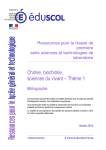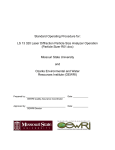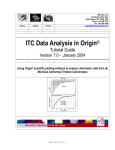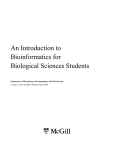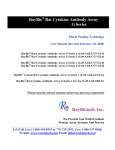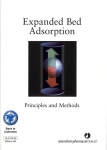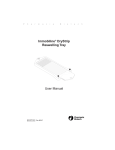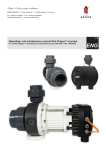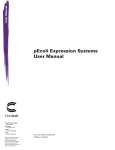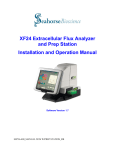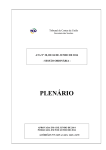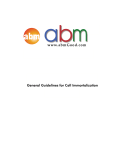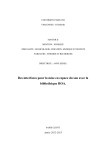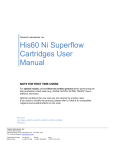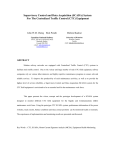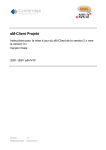Download CLONTECH
Transcript
CLONTECH Innovative Tools to Accelerate Discovery HAT Protein Expression and Purification System User Manual TM PT3250-1 (PR16705) Published 01 October 2001 Catalog #: K6050-1 See List of Components for storage conditions FOR RESEARCH USE ONLY HATTM System User Manual Table of Contents I. Introduction 4 II. List of Components 8 III. Additional Materials Required 9 IV. Cloning Recombinant Proteins Containing HAT A. Use of HAT Purification Sequence in Other Vectors B. Transformation of Host Cells with HAT Expression Vectors 10 10 10 V. HAT System Protocol: General A. General Information B. Protein Expression C. Buffers for Extraction and Purification of HAT-tagged Proteins 11 11 12 13 VI. HAT System Protocol: Isolation A. Isolation of Native HAT Proteins B. Isolation of Denatured HAT Proteins 15 15 16 VII. HAT System Protocol: Purification A. General Information B. Batch/Gravity-flow Purification C. Large-Scale Batch Purification D. Medium-Pressure (FPLC) Column Purification E. Resin Washing, Reuse, Regeneration, and Storage 17 17 18 19 21 22 VIII. References 23 IX. 24 Related Products Appendix A: Vector Information 25 Appendix B: Troubleshooting Guide 27 Appendix C: Reagent Compatibility 30 CLONTECH Laboratories, Inc. 2 www.clontech.com Protocol # PT3250-1 Version # PR16705 HATTM System User Manual Table of Contents, continued List of Figures Figure 1. Overview of Purification with the HAT System Figure 2. pHAT10/11/12 Vector Map and MCS Figure 3. pHAT20 Vector Map and MCS 7 25 26 Notice to Purchaser: The use of TALONTM products are covered under U.S. Patent #5,962,641. HATTM, TALONTM ,TALONspinTM, TALON-NXTM, and ProTetTM are trademarks of CLONTECH Laboratories, Inc. Sepharose® is a registered trademark of Pharmacia LKB Biotechnology. Triton® is a registered trademark of Rohm and Haas Co. Superflow TM and UniflowTM are trademarks of Sterogene Bioseparations, Inc. This product is intended to be used for research purposes only. It is not to be used for drug or diagnostic purposes nor is it intended for human use. CLONTECH products may not be resold, modified for resale, or used to manufacture commercial products without written approval of CLONTECH. © 2001, CLONTECH Laboratories, Inc. All rights reserved. Protocol # PT3250-1 Version # PR16705 www.clontech.com CLONTECH Laboratories, Inc. 3 HATTM System User Manual I. Introduction In order to perform such a diverse array of functions, proteins have evolved very complex structures. As a result, their physicochemical properties vary greatly, posing difficulties for the development of purification protocols with wide applicability. One way to circumvent this problem is to incorporate a purification tag into the primary amino acid sequence of a protein of interest, thus constructing a recombinant protein with a general binding site that allows purification under general conditions. The HATTM Sequence is one such purification tag. It is a histidine-rich sequence that confers to the protein an affinity for immobilized dimetal ions such as cobalt, nickel, and zinc. Immobilized Metal Affinity Chromatography (IMAC) Immobilized Metal Ion Affinity Chromatography (IMAC) was introduced in 1975 by Porath et al. (Porath et al., 1975) as a group specific affinity principle for separating proteins. The principle is based on the reversible interaction between some amino acid side chains and immobilized metal ions. Depending on the type of immobilized metal ion, different side chains can be involved in the adsorption process. Most notably, histidine, cysteine, and tryptophan side chains have been implicated in the binding of proteins to immobilized transition metal ions and zinc (Porath, 1985; Sulkowski, 1985; Hemdan & Porath, 1985a; Hemdan & Porath, 1985b; Zhao et al., 1991). The chelating ligand used for immobilization of the metal ions can influence the selectivity, capacity, and strength of immobilization of the metal ions to the matrix. Chelating ligands such as iminodiacetate (IDA) and dipicolylamine (DPA) (forming three coordination bonds with the metal ion), TALONTM and nitrilotriacetate (NTA) (forming four coordination bonds with the metal ion) and tris(carboxymethyl)ethylenediamine (TED) (forming five coordination bonds with the metal ion) have found numerous applications for the purification of native proteins (Porath, 1990; Wong et al., 1991; Arnold, 1991; Andersson, 1992). Widespread application of recombinant genetic technologies has fostered the production of recombinant proteins containing polyhistidine tags on their N- or Ctermini (Hochuli et al., 1987; Hochuli et al., 1988). HAT is one such tag. The HAT Protein Expression and Purification System is a complete system containing vectors designed for bacterial expression of HAT-tagged proteins, and reagents for purification of HAT-tagged proteins. The HAT sequence (patent pending) is a novel IMAC affinity tag derived from a unique natural protein sequence in chicken lactate dehydrogenase. It contains six histidines unevenly interleaved by other amino acid residues (see Figure 2 in Appendix A). The novel tag does not have the excessive positive charge characteristic of the commonly used 6xHis tag, thus HAT-fusion proteins have better solubility and similar affinity towards immobilized transition metal ions and zinc. HAT fusion proteins can be adsorbed in the absence of imidazole at neutral pH. As a result the alkaline proteases present in cell lysates are less active, and therefore most proteins are more stable. The core of the HAT system is the set of pHAT Vectors for protein expression in CLONTECH Laboratories, Inc. 4 www.clontech.com Protocol # PT3250-1 Version # PR16705 HATTM System User Manual I. Introduction continued Escherichia coli. Three vectors—pHAT10, pHAT11 and pHAT12—contain the multiple cloning site (MCS) in all three frames to allow easy cloning of the cDNA of interest for fusion to the HAT tag. Another vector—pHAT20—provides alternative restriction sites. The presence of a conveniently located enterokinase proteolytic site between the HAT sequence and the MCS provides the means for removal of the affinity tag and obtaining the wild type protein. See Appendix A for more information. Properties of the HAT Protein Expression and Purification System: • Evenly distributed charge throughout the affinity tag. No excessive positive charge and therefore, easier to elute from the column. • Affinity tag based on unique natural sequence (lower risk of toxicity of the recombinant proteins to the host cell). • Loading and purification at physiological pH 7.0 (using imidazole). • Purification in one chromatographic step with two buffers - load + wash & elute. • Elution at pH 6.0 (mild change in pH from the loading conditions at pH 7.0). • HAT tag does not contribute to protein insolubility and/or aggregation. Cloning in the pHAT Vectors The successful expression of HAT-tagged proteins in E. coli with the pHAT vectors is accomplished through use of the lacZ promoter. The pHAT Vectors are derived from the pUC19 vector and fully utilize its promoter-translation system. The HAT amino acid sequence derives from the N-terminus of chicken muscle lactate dehydrogenase—a sequence that is unique among reported protein sequences. This sequence has remarkable affinity towards transition metal ions and zinc, a property that has been utilized for the successful purification of chicken lactate dehydrogenase in one chromatographic step from crude cell extract. The sequence responsible for binding was identified after cleavage of the enzyme and subsequent purification of the peptide mixture under the conditions used for purification of the native enzyme. TALONTM IMAC Resins CLONTECH's TALON resins are agarose-based IMAC resins utilizing the high specificity of immobilized Co2+ ions for purification of polyhistidine recombinant proteins. Adsorption selectivity in IMAC increases in the following order: Cu2+ < Ni2+ < Zn2+ < Co2+ (Porath, 1992). The ligand used for immobilization of the metal ion is a tetradentate chelator that retains Co2+ ions strongly, thus eliminating problems stemming from metal ion leakage that could be detrimental to the biological activity of the proteins being purified (in stark contrast to IDA based adsorbents). Since immobilized Co2+ ions possess the highest possible specificity for polyhistidine-tagged proteins while adsorbing very low amounts of unwanted proteins (unlike Ni2+ based adsorbents), TALON is the best tool for purification of polyhistidine tagged proteins. Protocol # PT3250-1 Version # PR16705 www.clontech.com CLONTECH Laboratories, Inc. 5 HATTM System User Manual I. Introduction continued Overview of TALON Resins The following is a list of different formats for various purification needs. See Section IX for ordering information. • TALONTM Metal Affinity Resin is useful for batch and low-pressure chromatographic applications. TALON Resin utilizes Sepharose® CL-6B (Pharmacia LKB Biotechnology), a durable substrate that performs very well under native and denaturing conditions in centrifuge-mediated purification schemes. The large pore size resin has a high-binding capacity. • TALONTM Superflow Resin is useful for a range of applications, including medium pressure applications with FPLC systems at back pressures of up to 150 psi (1 MPa) and high flow rates up to 5 ml per cm2 per min. This resin is recommended if short purification times are essential, or if purification protocols developed at bench scale will be scaled up for larger volumes. TALON Superflow utilizes SuperflowTM-6 (Sterogene Bioseparations, Inc.), an agarose-based medium featuring a unique polysaccharide composition that resists biological degradation. Superflow-6 beads are also stabilized by a chemical crosslinking reaction that allows flow rates up to 10 times higher than are possible with regular crosslinked beads. • TALONTM CellThru is a novel IMAC resin for purifying polyhistidine-tagged proteins from crude cell lysates, sonicates, and fermentation liquids. The larger bead size of TALON CellThru (300–500 µm) permits cellular debris to flow through the column, eliminating the need for high-speed centrifugation. With TALON CellThru, destabilizing factors are removed more quickly than with other resins, because the number of steps are reduced. CellThru 2-ml & 10-ml Disposable Columns have a large filter pore size (90– 130 µm) that allows cellular debris to flow through the column during the purification process. The 2-ml columns are suitable for 1–2 ml bed volumes, while the 10-ml columns are suitable for 5–10 ml bed volumes. • TALONspinTM Columns are ideal for rapidly and simultaneously purifying small amounts of polyhistidine-tagged proteins. TALONspin Columns are recommended for single-use applications or for use as mini gravity-flow columns. Each column contains 0.5 ml of TALON-NXTM Resin, which is optimized for performance in a spin column. Each column will yield 2–4 mg of polyhistidine-tagged protein; exact yields will vary with conditions used and polyhistidine-tagged protein characteristics. In addition, yield and purity will depend upon expression level and lysate concentration. Beginning with the clarified sample, the entire procedure takes approximately 30 minutes. All resins have a capacity of at least 12 µmol Co2+ per ml of bed volume and are provided charged with the metal ion for ease of use. TALON-based adsorbents can also be regenerated (see Section VII.E). Used in concert with the HAT tag, TALON adsorbents deliver the best possible performance under mild physiological conditions. CLONTECH Laboratories, Inc. 6 www.clontech.com Protocol # PT3250-1 Version # PR16705 HATTM System User Manual I. Introduction continued Native purification of Soluble HAT protein Denaturing purification of Insoluble HAT protein Equilibrate resin* Load sample* Native purification buffer: 50 mM sodium phosphate, 300 mM NaCl, pH 7.0 Wash nonadsorbed material* Denaturing purification buffer: 50 mM sodium phosphate, 300 mM NaCl, 6 M Guanidinium-HCl, pH 7.0 Apply to TALON resin Wash* Elution* Imidazole elution: buffer + 100 mM imidazole pH elution: buffer at pH 6.0, followed by buffer at pH 5.0 Pure soluble HAT protein Imidazole elution: buffer + 100 mM imidazole Pure insoluble HAT protein Figure 1. Overview of purification with the HAT System. This flowchart outlines the procedures for native and denaturing purification of HAT-tagged proteins. Steps denoted with an asterisk involve the indicated buffer: the native purification buffer for native HAT-protein purification (soluble proteins), and the denaturing purification buffer for denaturing HAT-protein purification (insoluble proteins). See the protocol for detailed procedures. Protocol # PT3250-1 Version # PR16705 www.clontech.com CLONTECH Laboratories, Inc. 7 HATTM System User Manual II. List of Components Store vectors at –20°C. Store buffers and TALON Resin at 4°C. Store columns at room temperature. • • • • • • • • • • • 5 µg pHAT10 Vector (0.5 µg/µl) 5 µg pHAT11 Vector (0.5 µg/µl) 5 µg pHAT12 Vector (0.5 µg/µl) 2 µg pHAT-DHFR Control Vector (0.5 µg/µl) 10 ml TALON Resin 70 ml Buffer A (10X Extraction Buffer, pH 7.0) 10 ml Buffer B (1 M Imidazole) 10 ml Buffer C (10X Elution Buffer, pH 5.0) 40.1 g Guanidine HCl 10 Disposable Plastic Columns Vector Information Packet (PT3251-5) Buffer Compositions Buffer A: 0.5 M Sodium Phosphate; 3.0 M NaCl pH 7.0 (10X) Buffer B: 1.0 M Imidazole pH 7.0 (10X) Buffer C: 0.5 M Sodium phosphate; 3.0 M NaCl pH 5.0 (10X) The following kit components are also available separately: • TALON Metal Affinity Resin #8901-1,-2,-3,-4 • TALON 2-ml Disposable Gravity Columns #8903-1 CLONTECH Laboratories, Inc. 8 www.clontech.com Protocol # PT3250-1 Version # PR16705 HATTM System User Manual III. Additional Materials Required The following items are required for use with the HAT System, but are not included in the kit. For Cloning Recombinant Proteins: • Restriction enzymes • DNA polymerase • DNA ligase For Expression, Isolation, and Purification of HATTM -Tagged Proteins: • Centrifuge • Centrifuge tubes • Spectrophotometer • Electrophoretic system • Imidazole (Sigma, Cat. # I0250) for FPLC applications • pH meter For care of the TALONTM Resin • MES Buffer 20 mM 2-(N-morpholine)-ethanesulfonic acid (MES), pH 5.0 Protocol # PT3250-1 Version # PR16705 www.clontech.com CLONTECH Laboratories, Inc. 9 HATTM System User Manual IV. Cloning Recombinant HATTM-Proteins A. Use of the HAT Purification Sequence in Other Vectors The HAT sequence can be easily transferred to any other vector using the Hind III and Cla I sites surrounding the HAT sequence. If desired, the HAT and enterokinase cleavage sites can be excised together using the Hin d III site and a site in the MCS. If these sites are not convenient, the primers below can be used to amplify the HAT sequence with any desired terminal restriction sites (incorporated in the primers at the X): 5' primer 5' - X AGCTTGAAGGATCATCTCAT - 3' 3' primer 5' - X TCTTGTTGTGGGCATGAGCG - 3' To amplify the HAT sequence and EK site, use the 3' primer below: 3' primer 5' - X AAACAGTAGCAGTAGCTAGA - 3' B. Transformation of Host Cells with HAT Expression Vectors The following protocol is only an example for chemically induced transformation of E. coli competent cells. Any standard procedure, including electroporation, can be used for transformation. Perform control transformations with the Control Vector and without vector DNA in parallel. Note: Use JM109 or another lac-inducible cell line to see induction of expression. For tighter control of expression levels, use CLONTECH’s PROTet 6XHN Bacterial Expression System—especially recommended for expression of cytotoxic proteins. 1. On ice, thaw a tube containing 100 µl of 0.5 M 2-mercaptoethanol (2-ME) and one 50-µl tube of frozen E. coli competent cells for each ligation/transformation. 2. Dispense 2 µl of 0.5 M 2-ME into each tube of competent cells and mix. 3. Dispense 2 µl of each ligation reaction directly into the mixture from step 2. 4. Incubate the tubes on ice for 30 min. 5. Heat shock for exactly 30 sec in the 42°C water bath. 6. Remove the tubes from the 42°C water bath and place on ice for 2 min. 7. Add 250 µl of SOC medium (at room temperature) to each tube. 8. Shake the tubes horizontally at 37°C for 1 hr at 225 rpm in a rotary shaking incubator. 9. Spread all the transformation mixtures onto LB- ampicillin (50 µg/ml) agar plate containing X-gal (75 µg/ml) and IPTG (1 mM). Incubate the plates at 37°C overnight. 10. Pick up colonies, make a small plasmid preparation and sequence the region of the plasmid containing the HAT sequence and the sequence of interest (use the M13/pUC Reverse Sequencing Primer (–48) (24-mer), New England BioLabs, Cat. #1233). CLONTECH Laboratories, Inc. 10 www.clontech.com Protocol # PT3250-1 Version # PR16705 HATTM System User Manual V. HATTM System Protocol: General PLEASE READ ENTIRE PROTOCOL BEFORE STARTING. A. General Information 1. All manipulations as well as the centrifugation for removal of the cell debris should be carried out at 4–8 °C in order to improve the protein stability and yield. 2. The addition of a reducing agent such as up to 10 mM β2-mercaptoethanol or a protease inhibitor such as PMSF to the sonication buffer may improve the structural stability of fragile proteins during sample preparation. See Appendix C for compatibility information. Note: Depending on the concentration and volume of additive you wish to use, you may need to remake the buffers to preserve the recommended concentration of NaCl and buffering agent. DTT and DTE are not compatible with this TALON protocol in any concentration. 3. If there is a high level of proteolytic activity in the cell lysate, we recommend adding 1 mM EDTA to the extraction buffer to inhibit metalloproteases during the extraction. Before application of the sample to the TALON resin, EDTA must be removed by gel filtration on a column (PD-10, Amersham, Pharmacia) equilibrated with the loading buffer. In some cases, the host cell produces low molecular weight chelators that also must be removed by gel filtration prior to application of the sample to the TALON column. The presence of such chelators can be detected easily by application of your sample to a small column packed with the TALON adsorbent. If you observe that the top of the column is losing its characteristic pink color and the colorless front moves in the direction of the flow, or if you obtain pink colored fractions during batch adsorption, the sample needs to be equilibrated with a gel filtration column. 4. Overexpression of some recombinant proteins can lead to their accumulation in insoluble form as inclusion bodies. In order to determine optimal extraction/purification conditions, the distribution of the protein of interest in soluble and insoluble form must be determined. A preliminary SDS/PAGE analysis of the protein extracts obtained under native conditions followed by extraction of the residual proteins under denaturing conditions should be performed. One should take care to use the same extraction volumes for both the native and denaturing extracts and run the cell extract before induction as a control in one of the lanes in order to identify the protein of interest. Use of denaturing conditions is recommended only if the biological activity of the protein of interest has no relevance. It is preferable to use native conditions for extraction even if only 5 to 10% of the protein of interest is soluble. 5. The volumes given for the extraction buffers in the procedures below have been optimized for purification of the HAT-DHFR protein from Protocol # PT3250-1 Version # PR16705 www.clontech.com CLONTECH Laboratories, Inc. 11 HATTM System User Manual V. HATTM System Protocol: General continued 20–25 ml of an overnight E. coli culture. The volume of extraction buffer for overnight culture used may need to be adjusted for other proteins, dependent on the expression level and anticipated yield. 6. If you are purifying protein from harvested eukaryotic cells, lyse the cells in an appropriate lysis buffer containing a mild detergent (Sambrook et al., 1989). See Appendix C for compatible buffer additives. Note that EDTA and EGTA are not compatible with the TALON protocol because these reagents strip the cobalt from the resin. 7. Carefully check the appearance of the sample after lysis or sonication. Bacterial samples often remain viscous from incomplete shearing of genomic DNA. Complete DNA fragmentation improves the HAT protein recovery and allows efficient removal of cellular debris during centrifugation. It is possible to decrease the viscosity of the sample by digestion for 20–30 min at room temperature with 2.5 µg/ml of DNase I (remember that proteolytic activity is much higher at room temperature). An alternative method is to dilute the sample 5-fold with loading buffer before applying it to the resin. This should not significantly affect recovery. B. Protein Expression 1. Grow an overnight culture of E. coli transformed with the plasmid encoding the HAT-protein of interest. If the amount of the protein that can be isolated from this culture is sufficient proceed to step 3 after taking a 1 ml sample for electrophoretic analyses. Centrifuge the 1 ml sample at 1,000–3,000 x g for 15 min at 4°C and store the cell pellet at –20°C after removal of the supernatant. Note: If there is a need for a large-scale preparation of the protein, proceed to step 2. 2. Use the overnight culture to inoculate a larger volume of medium if you need a greater quantity of the protein of interest (use 20 ml of overnight culture per 1 L of medium). Incubate with shaking for another 1 to 2 hr, until the culture has an absorbance of approximately 0.6 OD600 measured against the starting medium). Remove a 1 ml sample of the culture, centrifuge at 1,000–3,000 x g for 15 min at 4°C, remove the supernatant and store the cell pellet at –20°C for electrophoretic analysis. 3. Induce expression by addition of an appropriate inducer (the lac promoter in the pHAT vectors can be induced with 1 mM IPTG). Continue the incubation for another 3–5 hours. 4. Remove a 1 ml sample of the culture, centrifuge at 1,000–3,000 x g for 15 min at 4°C, remove the supernatant and store the cell pellet at –20°C for electrophoretic analysis. CLONTECH Laboratories, Inc. 12 www.clontech.com Protocol # PT3250-1 Version # PR16705 HATTM System User Manual V. HATTM System Protocol: General continued C. Buffers for Extraction and Purification of HAT-tagged Proteins 1. Buffers for native purification of HAT-tagged proteins We suggest the following buffers for the purification of HAT recombinant proteins under nondenaturing conditions; however, other compatible buffers may be used. Imidazole-based purifications performed at pH 7.0 are generally recommended (eluted material is less diluted) especially when the HAT protein of interest cannot tolerate pH changes. We recommend adding 300 mM NaCl to reduce electrostatic interactions that result in nonspecific binding of unwanted proteins to the adsorbent. Alternative salt additives may provide better results for certain HAT-proteins. Before planning buffer compositions, please consult Appendix C. Note: After storage at 4°C, you may observe a precipitate in one or more of the provided 10X buffers. If this occurs, warm the buffer to room temperature to redissolve the precipitate and continue as indicated below. Extraction (loading) Buffera,b 50 mM sodium phosphate; 300 mM NaCl pH 7.0 (final pH) Dilute 5 ml of Buffer A with 45 ml of deionized water. Check and adjust pH if necessary. Elution Buffer • Imidazole elution: 50 mM sodium phosphate; 300 mM NaCl; 100 mM imidazole pH 7.0 (final pH) Add 1 ml of Buffer B to 1 ml of Buffer A and dilute with 8 ml of deionized water. Check and adjust pH if necessary. • pH elution: For monomers: 50 mM sodium phosphate; 300 mM NaCl pH 6.0 (final pH) Mix 0.5 ml of Buffer A with 0.5 ml of Buffer C and dilute with 9 ml of deionized water. Check and adjust pH if necessary. For dimers: 50 mM sodium phosphate; 300 mM NaCl pH 5.0 (final pH) Dilute 1 ml of Buffer C with 9 ml of deionized water. Check and adjust pH if necessary. Protocol # PT3250-1 Version # PR16705 www.clontech.com CLONTECH Laboratories, Inc. 13 HATTM System User Manual V. HATTM System Protocol: General continued 2. Buffers for denaturing purification of HAT-tagged proteins Extraction (loading) Buffer 50 mM sodium phosphate; 300 mM NaCl; 6 M Guanidine-HCl pH 7.0 (final pH) Dissolve the 40.1 g of guanidine-HCl in 7 ml of Buffer A and 10 ml of deionized water. Mix until guanidine-HCl is completely dissolved (~1 hr). Check pH. Add deionized water to a final volume of 70 ml. Elution Buffer • Imidazole elution 45 mM sodium phosphate; 270 mM NaCl; 5.4 M Guanidine-HCl; 100 mM imidazole pH 7.0 (final pH) Add 0.5 ml of Buffer B to 4.5 ml of the extraction/loading buffer for denatured HAT proteins. Check pH. a All volumes given are calculated for approximately one purification of protein from 25 ml culture using 1 ml of TALON adsorbent. b If intermediate wash before elution is necessary use the following wash buffers: - For native purification: Mix 1 ml of Buffer A with 50 µl of Buffer B and dilute with 8.95 ml of deionized water. Check pH. - For denaturing purification: Mix 50 µl of Buffer B with 9.95 ml of the extraction/loading buffer for denatured HAT proteins. Check pH. CLONTECH Laboratories, Inc. 14 www.clontech.com Protocol # PT3250-1 Version # PR16705 HATTM System User Manual VI. HATTM System Protocol: Isolation These are general guidelines. Some modifications may be required, particularly for eukaryotic expression or fragile enzyme systems. Chilling samples on ice before and during extraction may be necessary to preserve protein functionality. Extraction buffer volumes may also need to be adjusted according to cell pellet size and anticipated protein yield. As a starting point for scaling up, use 2 ml of extraction buffer per 20–25 ml of culture. A. Isolation of native HAT proteins 1. Harvest the cell culture by centrifugation at 1,000–3,000 x g for 15 min at 4°C. Remove the supernatant. If yield is low, use the mild extraction method described in step 6. 2. Resuspend the cell pellet by vortexing in 2 ml of chilled extraction buffer (4°C) per 25 ml of culture for small preparations (less than 100 ml). Use 1–2 % of the volume of the culture for large preparations (1 L or more). 3. (Steps 3 and 4 may be omitted if lysozyme treatment interferes with the functionality of your protein). Add lysozyme to the extraction buffer to a concentration of 0.75 mg/ml. To reduce the chance of introducing proteases, use the highest purity lysozyme available. 4. Incubate at room temperature for 20–30 min (Incubations at room temperature result in elevated proteolytic activities. Alternatively, lysozyme can be used at 4°C with lower efficiency. If the protein of interest is hydrolyzed by this treatment, use the method described in step 6. Alternatively, disrupt the cells by repeated freeze/thaw cycles, i.e., flash-freezing the cell suspension in a dry ice-ethanol bath and thawing in chilled H2O). 5. Thoroughly sonicate the cells using a series of short, repetitive bursts. Use the minimum time necessary to disrupt the cells (3 x 10 seconds with 30 second pauses on ice for small preparations (≤ 50 ml) or 3 x 30 seconds with 2 min pauses on ice for large preparations (≥ 200 ml). Proceed to step 7. Note: Excessive sonication can destroy protein functionality. 6. (Optional) High-yield, mild extraction method: Transfer the cells to a chilled mortar and grind 1 part cells with 2.5 parts of Alumina (Sigma #A-2039) for 2–3 minutes (until paste-like composition forms. Add chilled (4°C) extraction buffer (2 ml per 25 ml culture). Proceed to step 7. Note: If there is a high level of proteolytic activity in the cell lysate, we recommend adding 1 mM EDTA (final concentration) to the extraction buffer (in order to inhibit metalloproteases during the extraction). Before application of the sample to the TALON adsorbent, EDTA must be removed by gel filtration on a column (PD-10, Amersham, Pharmacia) equilibrated with the loading buffer for IMAC. 7. Centrifuge the cell extract at 10,000–12,000 x g for 20 min at 4°C to pellet any insoluble material. Protocol # PT3250-1 Version # PR16705 www.clontech.com CLONTECH Laboratories, Inc. 15 HATTM System User Manual VI. HATTM System Protocol: Isolation continued 8. Carefully transfer the supernatant to a clean tube without disturbing the pellet. This is the clarified sample. 9. Set aside a small portion of the clarified sample at 4°C to run on an analytical SDS/PAGE gel in parallel with the TALON-purified sample, to estimate yield and purity. 10. If this is the first time you have prepared clarified samples from cells expressing a particular recombinant protein, we recommend that you estimate the protein’s expression level in that host strain. To do so, perform a small-scale purification, and then analyze a small portion by SDS/PAGE in parallel with known amounts of protein standards to estimate the amount of HAT protein in the clarified sample. Once satisfactory expression is observed, proceed with the appropriate purification protocol, below. B. Isolation of denatured HAT proteins These are general guidelines for using denaturing conditions with bacterial expression cultures. Some modifications may be required for eukaryotic expression systems. Sonication buffer volumes may also need to be adjusted according to cell pellet size and anticipated protein yield. For scaling-up, use 2 ml of sonication buffer per 20–25 ml of culture. 1. Harvest 20–25 ml of cell culture by centrifugation at 1,000–3,000 x g for 15 min at 4°C. 2. Resuspend the pellet in 2 ml of extraction buffer per 20–25 ml of culture. 3. Gently agitate or stir the sample until it becomes translucent. 4. Centrifuge the sample at 10,000–12,000 x g for 20 min at 4°C to pellet any insoluble material. 5. Carefully transfer the supernatant to a clean tube without disturbing the pellet. This is the clarified sample. 6. Set aside a small portion of the clarified sample at 4°C to analyze by SDS/PAGE gel in parallel with the TALON-purified sample, to estimate yield and purity. Note: Samples containing 6 M guanidinium-HCl must be dialyzed overnight against buffer containing 8 M urea before loading on a gel. CLONTECH Laboratories, Inc. 16 www.clontech.com Protocol # PT3250-1 Version # PR16705 HATTM System User Manual VII. HATTM System Protocol: Purification A. General Information Choice of purification conditions The following general guidelines can be used for purification of a HAT-tagged protein from transformed E. coli cultures. The buffers and purification conditions (see the Buffers section and Figure 1) should work well for most soluble, monomeric proteins expressed in E. coli. Each different expression system and HAT-protein should be tested initially in small-scale batch purification to determine expression levels and to optimize the protocol. If you have any difficulties with the procedure, please refer to the Troubleshooting Guide (Appendix B). Choosing the buffers: pH gradient versus imidazole gradient TALON purification schemes typically use either a pH gradient or an imidazole gradient for washing and elution. The presence of imidazole in the wash and/or loading buffer minimizes nonspecific binding and reduces the amount of contaminating proteins. Thus, purification using an imidazole gradient is the generally preferred procedure, and should be tried first. However, both imidazole and HAT proteins absorb at 280 nm, so elution peaks may be difficult to detect spectrophotometrically, especially when purifying small amounts of HAT-protein. In these cases, the leading edge of the imidazole breakthrough peak should be collected and checked for the presence of HAT-protein by a protein specific assay (Bradford, 1976) and SDS/PAGE analysis. Alternatively, a pH gradient may be used instead of imidazole for purification of HAT proteins that are stable in the pH range of 6.0–7.0. Buffers containing EDTA or EGTA will elute all HAT proteins, but will also strip the metal off the resin. Thus, the purified protein will contain cobalt (in addition to EDTA or EGTA), which can inhibit protein function and lead to precipitation. Elution strategy: linear versus step gradients In most cases, step gradients are preferred over linear gradients, because linear gradients lead to broad elution peaks which can dilute the product and make detection difficult. Reusing TALONTM Resin Used TALON Resin may be stored and reused up to 3–4 times before discarding or complete regeneration (Section VIII.E); the exact number of uses varies dependent on the applications. To avoid possible crosscontamination, use a particular aliquot of resin only for the purification of a single type of HAT protein. Protocol # PT3250-1 Version # PR16705 www.clontech.com CLONTECH Laboratories, Inc. 17 HATTM System User Manual VII. HATTM System Protocol: Purification continued B. Batch/Gravity-Flow Column Purification 1. Thoroughly resuspend the TALON Resin to achieve a homogeneous 50% suspension of resin in the storage solution (it will settle during shipping and storage). TALON resin is shipped as a 20% ethanol suspension. 2. Immediately transfer the required amount of resin suspension to a sterile tube that will accommodate 10–20X the resin bed volume. Use 2 ml of resin suspension per ~3 mg of anticipated HAT protein. 2 ml of homogeneously resuspended resin will provide 1 ml (bed volume) of TALON Resin. 3. Centrifuge at 700 x g for 2 min to pellet the resin. 4. Remove and discard the 20% ethanol supernatant. 5. Add 10 bed-volumes of extraction/loading buffer and mix briefly to preequilibrate the resin. 6. Recentrifuge at 700 x g for 2 min to pellet the resin, and discard the supernatant. 7. Repeat steps 5 and 6. 8. Add the clarified sample from Section VI to the resin. 9. Gently agitate the suspension at room temperature for 20 min on a platform shaker to allow the HAT protein to bind to the resin. 10. Centrifuge at 700 x g for 5 min. 11. Carefully remove as much supernatant as possible without disturbing the resin pellet. 12. Wash the resin by adding 10 bed-volumes of extraction/loading buffer (pH 7.0). Gently agitate the suspension at room temperature for 10 min on a platform shaker to promote thorough washing. 13. Centrifuge at 700 x g for 5 min. 14. Remove and discard the supernatant. 15. Repeat the above wash (Steps 11–14). 16. Add one bed-volume of the extraction/loading buffer to the resin and resuspend by vortexing. 17. Transfer the resin to a 2-ml gravity flow column with an end-cap in place and allow the resin to settle out of suspension. 18. Remove the end-cap and allow the buffer to drain until it reaches the top of the resin bed, making sure no air bubbles are trapped in the resin bed. 19. Wash column once with 5 bed volumes of extraction/loading buffer. CLONTECH Laboratories, Inc. 18 www.clontech.com Protocol # PT3250-1 Version # PR16705 HATTM System User Manual VII. HATTM System Protocol: Purification continued 20. (Optional) If necessary, the wash may be performed under more stringent conditions using 5 mM imidazole in the extraction/loading buffer (see Section V footnotes). 21. Elute the HAT-protein by adding 5 bed-volumes of elution buffer (100 mM imidazole in the loading buffer or pH 6.0 buffer) to the column. Collect the eluate in 500-µl fractions. Note: Under most conditions, a majority of the HAT protein will be recovered in the first two bed-volumes. 22. (Optional) In order to ensure that all HAT-tagged protein is recovered, elute with 5 bed-volumes of stronger elution buffer (200 mM imidazole in the extraction/loading buffer or pH 5.0 buffer for pH elution). Collect the eluate in 500-µl fractions. 23. Use spectrophotometric and SDS/PAGE analyses to determine which fraction(s) contains the majority of the HAT-protein. C. Large-Scale Batch Purification Pure HAT protein is obtained much faster with this method, compared to using gravity-flow columns. However, batch washes are somewhat less efficient at removing impurities than are gravity-flow columns. Therefore, larger wash buffer volumes are needed to get pure HAT protein. Very little unwanted protein should bind to TALON at pH 7.0. It is generally sufficient to wash the resin-bound HAT-protein complex 3–4 times with 10 bed volumes of pH 7.0 loading buffer and proceed with elution. If additional stringent washes are needed to achieve the desired purity level, include Step 17. 1. Thoroughly resuspend the TALON Resin to achieve a homogenous 50% suspension of resin in the storage solution (it will settle during shipping and storage). TALON resin is shipped as a 20% ethanol suspension. 2. Immediately transfer the required amount of resin suspension to a sterile tube that will accommodate 10–20X the resin bed volume. Use 2 ml of resin suspension per ~3 mg of anticipated HAT protein. 2 ml of homogeneously resuspended resin will provide 1 ml (bed volume) of TALON Resin. 3. Centrifuge at 700 x g for 2 min to pellet the resin. 4. Remove and discard the 20% ethanol supernatant. 5. Add 5 bed-volumes of extraction/loading buffer (pH 7.0) and mix briefly to pre-equilibrate the resin. 6. Recentrifuge at 700 x g for 2 min to pellet the resin, and discard the supernatant. Protocol # PT3250-1 Version # PR16705 www.clontech.com CLONTECH Laboratories, Inc. 19 HATTM System User Manual VII. HATTM System Protocol: Purification continued 7. Repeat steps 5 and 6. 8. Add the clarified sample from Section VI to the resin. 9. Gently agitate the suspension at room temperature for 20 min on a platform shaker to allow the HAT-protein to bind to the resin. 10. Centrifuge at 700 x g for 5 min. 11. Carefully remove as much supernatant as possible without disturbing the resin pellet. 12. Wash the resin-protein complex by adding 10 bed-volumes of extraction/loading buffer (pH 7.0). 13. Gently agitate the suspension at room temperature for 10 min on a platform shaker to promote thorough washing. 14. Centrifuge at 700 x g for 5 min. 15. Remove and discard the supernatant. 16. Repeat the above wash (Steps 12–14) 2–3 times. 17. (Optional) If more stringent washing is needed to achieve the desired purity, add 5 bed volumes of wash buffer (5 mM imidazole in the extraction/loading buffer) and gently agitate the suspension at room temperature for 10 min. Centrifuge at 700 x g for 5 min to pellet resin. Remove and discard the supernatant. 18. Elute the HAT-protein by adding 1 bed-volume of elution buffer (100 mM imidazole in the loading buffer or pH 6.0 buffer). 19. Gently agitate the suspension at room temperature for 10 min. 20. Centrifuge at 700 x g for 5 min. 21. Collect supernatant. 22. Repeat Steps 17–20 three times, collecting four separate, 1-bed-volume fractions. 23. (Optional) In order to ensure that all HAT-tagged protein is recovered, elute with 4 bed-volumes of stronger elution buffer (200 mM imidazole in the loading buffer or pH 5.0 buffer for pH type elution) by repeating steps 18 through 20. 24. Use spectrophotometric and SDS/PAGE analyses to determine which fraction(s) contains the majority of the HAT-protein. CLONTECH Laboratories, Inc. 20 www.clontech.com Protocol # PT3250-1 Version # PR16705 HATTM System User Manual VII. HATTM System Protocol: Purification continued D. Medium-Pressure (FPLC) Column Purification (for TALONTM Superflow only) 1. Consult the manufacturer’s instructions for FPLC column assembly. 2. Thoroughly resuspend the TALON Superflow resin to achieve a homogeneous 50% suspension of resin in the storage buffer. Slowly pour the slurry into the column, taking care to avoid the introduction of air bubbles. 3. Allow the resin to settle. This process can be accelerated by allowing the buffer to flow through the column with a peristaltic pump. Do not exceed a flow rate of 5 ml/min/cm2. Do not allow the resin to dry out. If this occurs, resuspend the resin in Extraction (loading) Buffer and repack the column. 4. Insert and adjust the top adaptor and connect the column to the chromatography system according to FPLC system specifications. Note: Avoid trapping air between the adaptor and the resin surface. 5. Equilibrate the column with Extraction (loading) Buffer. Do not exceed a 5 ml/min/cm2 flow rate. Monitor the eluant at 280 nm; the baseline should be stable after washing with 5–10 column volumes. 6. Apply the clarified sample to the column after filtering it through a 0.22 µm filter and wash with Extraction (loading) Buffer until the baseline (280 nm) is stable. Monitor column backpressure during sample application. Start collecting fractions. Note: If the sample is very viscous, the column pressure may exceed the recommended value (150 psi, 1.0 MPa). Reduce the flow rate or dilute the sample to bring the pressure into an acceptable range. Load the sample at a flow rate of 0.5–1.0 ml/min/cm2 to ensure binding of the HAT-tagged protein to the resin. If the protein does not bind, the flow rate should be reduced further. The flow rate can be increased later for washing and protein elution. If the protein of interest is not very stable at room temperature, the chromatography can be performed at 4°C. Also, higher flow rates of up to 5 ml/min/cm2 can be used to wash and elute the protein: Recovery may decrease by 10–15%, but a chromatography run will take less time (15–20 min average elution). 7. Wash column with Extraction (loading) Buffer followed by wash buffer (5–10 mM imidazole in extraction/loading buffer) until the baseline at 280 nm is stable (usually 10–20 column-volumes). 8. Elute the protein using the Elution Buffer (100–200 mM imidazole gives best results). Five column-volumes are usually sufficient for elution. The HAT protein usually elutes in the second and third columnvolumes. 9. Use spectrophotometric and SDS/PAGE analyses to determine which fraction contains the majority of the HAT-protein. Protocol # PT3250-1 Version # PR16705 www.clontech.com CLONTECH Laboratories, Inc. 21 HATTM System User Manual VII. HATTM System Protocol: Purification continued E. Resin Washing, Reuse, Regeneration, and Storage Generally, reuse TALON Resins 3–4 times before discarding or fully regenerating. The exact number of uses varies among preparations because of differences in redox potential, organic complexity, and debris content. To avoid possible cross-contamination, use a particular aliquot of resin to purify a single type of polyhistidine-tagged protein. Important precautions • Do not store TALON Resin in denaturants such as 6 M guanidinium. • Do not store TALON Resin with bound imidazole: the resin should be washed with 2-(N-morpholine)-ethanesulfonic acid (MES) buffer (pH 5.0) before reuse to remove the bound imidazole. 1. Stringent Wash (optional) A. Wash resin with four bed volumes of 6 M guanidinium (pH 5.0) + 1% nonionic detergent. B. Rinse resin with five bed volumes of distilled H2O. C. Store resin at 4°C in 20% nonbuffered ethanol containing 0.02% azide. 2. Removing Imidazole A. Wash resin with five bed volumes of 20 mM MES buffer (pH 5.0) containing 0.1 M NaCl. B. Rinse resin with five bed volumes of distilled H2O. C. Store resin at 4°C in 20% nonbuffered ethanol containing 0.02% azide. 3. Regeneration of TALON-Superflow Columns Purification of polyhistidine-tagged proteins using imidazole gradients will cause the column to take on a purplish hue. Washing the column with 5–10 column volumes of 20 mM MES buffer (pH 5.0) will restore the normal pink color and bring the absorbance at 280 nm back to the original baseline level. After equilibrating the column with Extraction/ Wash Buffer, the column is ready for reuse. 4. Complete Regeneration Strip the resin of cobalt ions by washing with 10 bed volumes of 0.2 M EDTA (pH 7.0). Wash excess EDTA with an additional 10 bed volumes of Milli-Q H2O. Charge the resin with 50 mM CoCl2 solution (10 bed volumes). Again, wash with 10 bed volumes of Milli-Q H2O to remove excess cobalt metal ions. Equilibrate the resin with extraction/wash buffer (10 bed volumes). CLONTECH Laboratories, Inc. 22 www.clontech.com Protocol # PT3250-1 Version # PR16705 HATTM System User Manual VIII. References Andersson, L. (1992). New developments in protein isolation, purification, and characterization. Cancer Invest 10(1):71–84. Arnold, F. H. (1991). Metal-Affinity Separations: A New Dimension in Protein Processing. Biotechnology 9:151–156. Bradford, M. (1976). A Rapid and Sensitive Method for the Quantitation of Microgram Quantities of Protein Utilizing the principle of Protein-Dye binding. Analytical Biochemistry 72:248–254. Hemdan, E. S., & Porath, J. (1985a). Development of Immobilized Metal Affinity Chromatography II. Interaction of amino acids with immobilized nickelimionodiacetate. Journal of Chromatography 323:255–264. Hemdan, E. S., & Porath, J. (1985b). Development of Immobilized Metal Affinity Chromatography III. Interaction of oligopeptides with immobilized nickelimionodiacetate. Journal of Chromatography 323:265–272. Hochuli, E., Bannwarth, W., Doebeli, H., Gentz, R., & Stueber, D. (1988). Genetic approach to facilitate purification of recombinant proteins with a novel metal chelate adsorbent. Bio/Technology 6(11):1321–5. Hochuli, E., Dobeli, H., & Schacher, A. (1987). New Metal Chelate Adsorbent Selective for Proteins and Peptides Containing Neighboring Histidine Residues. Journal of Chromatography 411:177–184. Porath, J. (1985). Immobilized Metal Ion Affinity Chromatography - a Powerful Method for Protein Purification. In H. Tschelsche (Ed.), Modern Methods in Protein Chemistry, (pp. 85-95). Berlin & NY: Walter de Gruyter & Co. Porath, J. (1990). Amino acid side chain interaction with chelate-liganded crosslinked dextran, agarose and TSK gel. A minireview of recent work. J. Mol. Recognit. 3(3):123–7. Porath, J. (1992). Immobilized Metal Ion Affinity Chromatography. Protein Express. Purif. 3:263–281. Porath, J., Carlsson, J., Olsson, I., & Belfrage, G. (1975). Metal chelate affinity chromatography, a new approach to protein fractionation. Nature 258:598–599. Sambrook, J., Fritsch, E. F., & Maniatis, T. (1989). Molecular Cloning: a laboratory manual, 2nd Edition Ed., Cold Springs Harbor Laboratory Press, Cold Springs Harbor, NY. Sulkowski, E. (1985). Purification of proteins by IMAC. Trends in Biotechn. 3:1–7. Wong, J. W., Albright, R. L., & Wang, N. H. L. (1991). Immobilized metal ion affinity chromatography (IMAC) - chemistry and bioseparation applications. Sep. Purif. Methods 20(1):49–106. Zhao, Y.-J., Sulkowski, E., & Porath, J. (1991). Surface topography of histidine residues in lysozymes. Eur. J. Biochem. 202:1115–1119. Protocol # PT3250-1 Version # PR16705 www.clontech.com CLONTECH Laboratories, Inc. 23 HATTM System User Manual IX. Related Products For the latest and most complete listing of all CLONTECH products, please visit www.clontech.com. • • • • • • • • • • • • • • • • • • • TALON Metal Affinity Resin TALON Superflow Metal Affinity Resin TALONspin Columns TALON 2-ml Disposable Gravity Columns 6xHis Monoclonal Antibody HAT Polyclonal Antibody TALON CellThru Resin Glutathione-Superflow Resin Glutathione-Uniflow Resin Thiophilic Uniflow Resin TALON CellThru 2-ml Disposable Columns TALON CellThru 10-ml Disposable Columns 6xHis Monoclonal Antibody (albumin free) 6xHN Polyclonal Antibody pHAT-GFPuv Vector pHAT20 Vector HATTM Sequencing Primers ProTetTM 6xHN Bacterial Expression System GST Purification Kit CLONTECH Laboratories, Inc. 24 www.clontech.com 8901-1,-2,-3,-4 8908-1,-2 8902-1,-2,-3,-4 8903-1 8904-1 8909-1 8910-1, -2 8911-1, -2 8912-1, -2 8913-1, -2 8914-1 8915-1 8916-1 8940-1 8920-1 8921-1 6468-1 K1628-1 K1251-1 Protocol # PT3250-1 Version # PR16705 HATTM System User Manual Appendix A: Vector Information HAT MCS Plac EK site pUC ori pHAT10/11/12 2.8 kb Ampr HAT Hind III A AGC TTG AAG GAT CAT CTC ATC CAC AAT GTC CAC AAA GAG GAG CAC GCT CAT GCC CAC AAC AAG Ser Leu Lys Asp His Leu Ile His Asn Val His Lys Glu Glu His Ala His Ala His Asn Lys EK cleavage site * ATCGATGACGATGACAAAGTCGACGGATCCCCGGGTACCGAGCTCGTAATTAGCTGAATTC Sal I BamH I Sma I Kpn I Sac I EcoR I Cla I Figure 2. pHAT10/11/12 Vector Map and MCS. (Unique restriction sites are in bold). The sequence of pHAT10 is shown. The asterisk indicates the insertion point of additional bases in pHAT11 (G) and pHAT12 (GG) that alter the reading frame of the MCS. These vectors encode a novel polyhistidine epitope tag that enables purification of expressed proteins at neutral pH. The pHAT Vectors allow protein purification under both native and denaturing conditions. The HAT epitope is a naturally occurring, 19-amino-acid sequence from the chicken lactate dehydrogenase protein. This sequence of nonadjacent histidine residues has lower overall charge than tags with consecutive His residues, such as the 6xHis tag. As a result, HAT-protein fusions exhibit solubility that more closely resembles that of wild-type proteins while still possessing strong affinity for immobilized metal ions. The unique binding characteristics of the HAT sequence allow both imidazole- and pHgradient purification of proteins under native conditions at neutral pH (7.0), as well as under denaturing conditions. The HAT sequence and an enterokinase (EK) cleavage site have been incorporated into the pUC19 backbone. The EK site allows for optional removal of the HAT sequence from the purified protein by treatment with enterokinase. Restriction sites allow excision of the HAT sequence, with or without the EK site, for cloning in other vectors. Protocol # PT3250-1 Version # PR16705 www.clontech.com CLONTECH Laboratories, Inc. 25 HATTM System User Manual Appendix A: Vector Information continued Hind III (141) HAT MCS (221–256) EcoR I (262) Plac EK site pUC ori ApaL I ApaL I (481) (2224) pHAT20 2.8 kb Ampr ApaL I (978) 190 180 170 160 150 200 HAT Hind III • • • • • • A AGC TTG AAG GAT CAT CTC ATC CAC AAT GTC CAC AAA GAG GAG CAC GCT CAT GCC CAC AAC AAG Ser Leu Lys Asp His Leu 204 • Ile His Asn 230 • Val His Lys Glu Glu 240 • His Ala His Ala His Asn Lys 250 • EK cleavage site ATC GAT GAC GAT GAC AAA GTT AAC CGG TCC CCG GGT ACC GGG CCC GGC CGG CC Hpa I Age I Sma I Kpn I Cla I Nae I Eag I Fse I Figure 3. pHAT20 Vector Map and MCS. Unique restriction sites are in bold. The sequence of pHAT20 is shown. This vector encodes a novel Histidine Affinity Tag (HATTM) that enables purification of expressed proteins at neutral pH. The pHAT Vectors allow protein purification under both native and denaturing conditions. The HAT epitope is a naturally occurring, 19-amino-acid sequence from the chicken lactate dehydrogenase protein. This sequence of nonadjacent histidine residues has lower overall charge than tags with consecutive His residues, such as the 6xHis tag. As a result, HAT-protein fusions exhibit solubility that more closely resembles wild-type proteins while still possessing strong affinity for immobilized metal ions. The unique binding characteristics of the HAT sequence allow both imidazole- and pH-gradient purification of proteins under native conditions at neutral pH (7.0), as well as under denaturing conditions. The HAT sequence and an enterokinase (EK) cleavage site have been incorporated into the pUC19 backbone. The EK site allows for optional removal of the HAT sequence from the purified protein by treatment with enterokinase. Restriction sites allow excision of the HAT sequence, with or without the EK site, for cloning in other vectors. CLONTECH Laboratories, Inc. 26 www.clontech.com Protocol # PT3250-1 Version # PR16705 HATTM System User Manual Appendix B: Troubleshooting Guide Protein Expression and Isolation A. No expression Bad vector construct Bad transformation No inducing agent Check the sequence of the vector. Make a plasmid miniprep to confirm sequence. Make sure that 1 mM IPTG is added to culture. B. Apparent low expression Insoluble overUse denaturing extraction and purification condiexpressed protein tions or reduce expression levels by lowering the amount of inducer. Unsuitable expression Check cell growth and inducer concentration; check conditions for wild type (non transformed) or contaminant antibiotic resistant cells Protein is secreted Check fermentation liquid for your protein. Use fermentation liquid as starting sample for IMAC after proper buffering C. Proteolysis Protein is hydrolyzed by proteases Use mild extraction conditions in presence of protease inhibitors, 2-mercaptoethanol and EDTA at 4°C (Remove EDTA before applying to TALON) Purification A. Loss of Co2+ Presence of chelators in sample Remove chelators from sample by gel filtration Regenerate adsorbent as described in Section VII.E B. HAT protein does not bind Use of wrong buffer Check pH, presence of imidazole or other weak for loading chelator (TALON resin changes color to ruby) and switch to appropriate buffer Protein hydrolyzed Use mild extraction conditions in presence of during extraction protease inhibitors, 2-mercaptoethanol and EDTA at 4°C (Remove EDTA before applying sample to TALON) HAT tag not exposed If the protein fails to bind under native conditions, then treat a small aliquot (<1 ml) with the denaturing protocol in Section VI.B. If the target protein binds to the resin under the denaturing conditions, Protocol # PT3250-1 Version # PR16705 www.clontech.com CLONTECH Laboratories, Inc. 27 HATTM System User Manual Appendix B: Troubleshooting Guide continued Binding interference then try to move the tag to the other terminus of the protein where it may be more exposed. See Appendix C for reagent compatibilities. If reagent is not listed, you can check binding using a small scale procedure. C. Resin changes color Loss of Pink Color Normally due to the presence of Chelators (e.g.,. EDTA, EGTA) that bind Cobalt. You may need to fully regenerate resin (Section VII.E) in order to reintroduce Cobalt to the resin. Purple or blue color Indicates presence of guanidinium in the resin. This does not indicate a change in the binding properties of the resin, nor does it indicate a problem. Grey or brown color: TALON overexposed to reducing agents Completely remove reducing agents such as DTE or DTT or substitute 2-mercaptoethanol, if possible. Decrease 2-mercaptoethanol concentration by dilution to 1–5 mM. D. High amount of co-eluted impurities Insufficient wash or Use larger volume of loading/wash buffer, elevate low salt concentration the salt concentration of the loading buffer (at least 0.3 M NaCl), use low concentration of imidazole (5–10 mM) at pH 7.0 to remove contaminants. Proteolytic product Use mild extraction conditions in presence of protease inhibitors, 2-mercaptoethanol and EDTA at 4°C (Remove EDTA before applying to TALON). Covalent attachment Use low concentration of 2-mercaptoethanol (Cys-Cys) of impurities (1–5 mM) in the extraction buffer. to the HAT protein Co-purifying histidine Use enterokinase to remove HAT tag and rerun* rich proteins IMAC with mixture: protein of interest will pass through the column, impurities and tag will be adsorbed. Co-purifying histidine Use second purification principle (Size Exclusion, rich proteins Ion Exchange, Hydrophobic, or Thiophilic Chromatography). CLONTECH Laboratories, Inc. 28 www.clontech.com Protocol # PT3250-1 Version # PR16705 HATTM System User Manual Appendix B: Troubleshooting Guide continued * Remove chelating ligands, metal ions or imidazole if present in the sample by gel filtration before loading the proteolytic mixture on the TALON adsorbent. E. HAT proteins do not elute Insufficient concenElute with 100 to 200 mM imidazole or pH 5.0 tration of imidazole in followed by pH 4.0. the elution buffer or insufficiently low pH of the buffer (possible if dimers and tetramers of HAT proteins form) F. High back pressure during load of sample High viscosity due to Use DNase I or dilute sample 5-fold. presence of DNA G. High back pressure in column Clogged filter from Change top filter of column, centrifuge sample subcellular debris extensively (20–30 minutes) at 4 °C & 12,000 x g. Precipitation of Use mild detergent such as Decanoyl-Nproteins on the methylglucamide (MEGA-10, Sigma # D-6277) in column the sample and loading buffer. Protocol # PT3250-1 Version # PR16705 www.clontech.com CLONTECH Laboratories, Inc. 29 HATTM System User Manual Appendix C: Reagent Compatibility A. Compatible reagents Table II shows the maximum concentrations of each reagent tested at CLONTECH. Higher levels may be acceptable, but they should be tested before use. Note that some of these reagents may partially or completely denature your protein. Reagent Acceptable Concentration β-Mercaptoethanol a 10 mM (with caution) 1% (with caution) 30% 30% 50 mM 20% 6M 200 mM at pH 7.0–8.0 500 mM 50 mM 20 mM 1.0 M 1% 1% with caution 50 mM 8M CHAPSb Ethanolc Ethylene glycol HEPES Glycerol Guanidinium a Imidazole d KCl MOPS MES NaCl NP-40 SDSb TRISe Urea a Resin should be used immediately after equilibrating the resin with buffers containing these reagents. Otherwise, the resin will change color. Resin should not be stored in buffers containing these reagents. b Ionic detergents like CHAPS (3-[(3-Cholamidopropyl)-dimethylammonio]-1-propane- sulfonate), SDS (sodium dodecyl sulfate) and Sarkosyl are compatible at up to 1%. However, due to their charged nature, interference with binding should be anticipated. c Imidazole can not be used at concentrations higher than 5–10 mM for loading of the d HAT-tagged proteins due to the fact that it competes with the histidine side chains (imidazole groups) for binding to the immobilized metal ions. Ethanol may cause precipitation of proteins. It is not recommended unless used for regeneration and storage of resin. B. Incompatible reagents The following reagents are not compatible with TALON in any concentration: • DTT (dithiothreitol) and DTE (dithioerythritol) • EDTA (ethylenediaminetetraacetic acid) and EGTA (ethylene glycolbis([β-amino-ethyl ether]) Note: Although you can use EDTA at indicated points, it must be removed from the sample by gel filtration or dialysis prior to applying the sample to TALON Resins. CLONTECH Laboratories, Inc. 30 www.clontech.com Protocol # PT3250-1 Version # PR16705 HATTM System User Manual Notes Protocol # PT3250-1 Version # PR16705 www.clontech.com CLONTECH Laboratories, Inc. 31
































